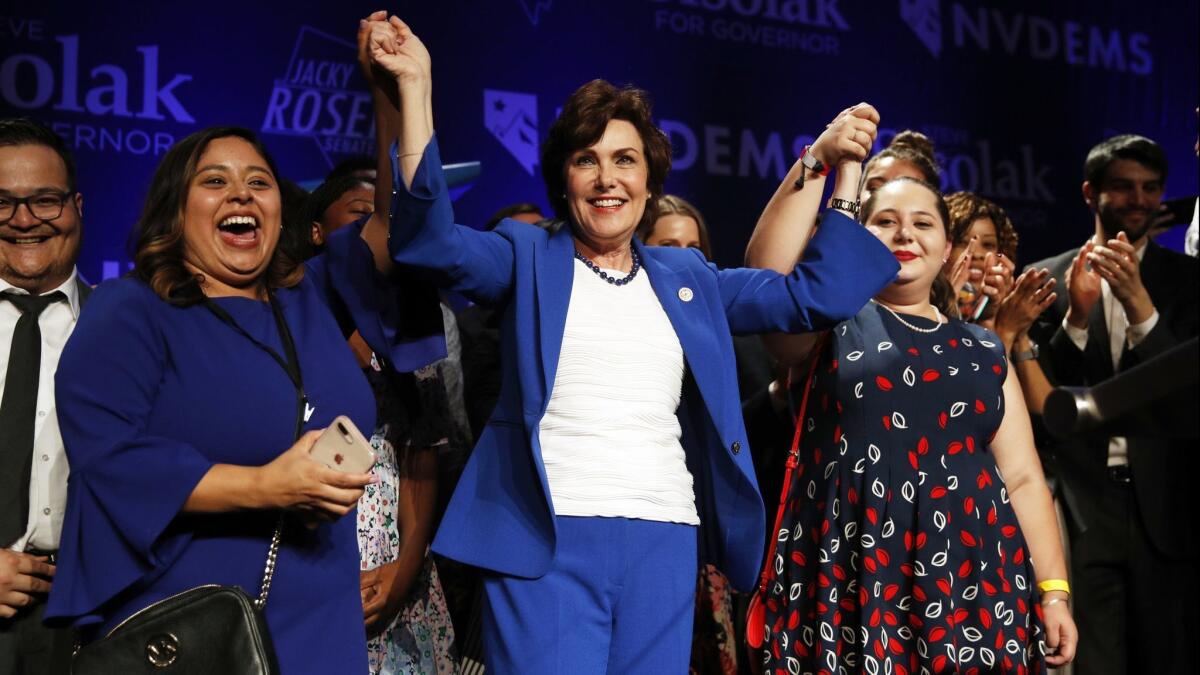Op-Ed: A record number of women were elected in the midterm, but we’re nowhere near gender parity in Congress

- Share via
When Congress convenes in January 2019, less than 25% of its members will be women.
That might come as a surprise to readers who have absorbed the narrative that 2018 is a “Year of the Woman” in American politics.
A record number of women did run for office, and a record number of women will join Congress next year. The largest-ever freshman class of women — at least 35 — will be sworn in to the House, breaking a record that is more than two decades old. (There were 24 female newcomers in 1993.) For the first time, more than 100 women will serve in the House. About a third of these new representatives will be women of color, including the first Native American women and the first Muslim women to serve in Congress.
But there will still be three men for every woman serving in Congress in 2019. And women still represented less than 25% of congressional candidates this year.
Even after the new female members are sworn in next year, achieving gender parity will require doubling the number of women serving in Congress.
There will still be three men for every woman serving in Congress in 2019.
This is the problem with reducing the coverage of women’s political progress to a slogan. It produces a simplistic narrative about women’s representation.
To be sure, the uptick in women has the potential to affect policy. In past interviews my colleagues and I conducted with 83 congresswomen, female lawmakers consistently pointed to the ways in which they expanded policy agendas and offered diverse perspectives in policy debates.
But as former Rep. Donna Edwards (D-Md.) noted in one of these interviews, Congress is far from having gender parity: “There’s just not enough of us, period.”
In fact, women’s representation among congressional Republicans will actually go down. Though Republicans will gain one or two women in the Senate, overall, women will remain less than 10% of the Republican caucus in Congress.
Democratic women are likely to have a greater impact on policy in the House, since they will benefit not only from higher numbers but also from their party’s majority status.
That said, their policy contributions are likely to be just as diverse as the women themselves. It is unreasonable to expect that simply adding more women will advance a single agenda or guarantee particular policy outcomes.
For nearly five decades, the Center for American Women and Politics has analyzed, and sought to address, the under-representation of women in government. Our research has illuminated structural, political and social barriers to women’s political candidacy.
Many stubborn hurdles remain. For example, men continue to dominate party leadership roles. Many women have less access to moneyed networks. And in order to be deemed qualified to run and viable to win, women are often expected to meet higher standards. All these obstacles are exacerbated for women of color.
This year’s election proved that women can clear these hurdles and win elected office, but the hurdles have not been dismantled.
The responsibility to remove these barriers should not fall on women’s shoulders alone. Long-term change will require both men and women to challenge underlying norms and address the many factors that deter women from running.
Enter the Fray: First takes on the news of the minute from L.A. Times Opinion »
Female candidates did a lot of this work in 2018. For instance, they offered new models for candidacy that valued their lived experiences and perspectives as women. They shared #MeToo stories, described the ways in which motherhood informs their politics and talked about resiliency in the face of discrimination.
Some challenged biases and stereotypes directly, as when Representative-elect Ayanna Pressley rejected the idea that she must constrain her outrage to avoid being perceived as an “angry black woman,” or when Representative-elect Alexandria Ocasio-Cortez stated that “women like me aren’t supposed to run for office,” but did anyway.
The effects of their candidacies could be lasting. In challenging our collective expectations, the women who ran in 2018 may have assured that their gains won’t be limited to a single election cycle.
But we should not declare “mission accomplished.” Although 2018 was an exceptional year for women in politics, we cannot afford to let the momentum dissipate. After everyone takes a much-needed breath, it will be time to get back to work.
Kelly Dittmar is an assistant professor of political science at Rutgers-Camden and a scholar at the Center for American Women and Politics. She is a co-author of “A Seat at the Table: Congresswomen’s Perspectives on Why Their Presence Matters.”
Follow the Opinion section on Twitter @latimesopinion or Facebook
More to Read
A cure for the common opinion
Get thought-provoking perspectives with our weekly newsletter.
You may occasionally receive promotional content from the Los Angeles Times.









